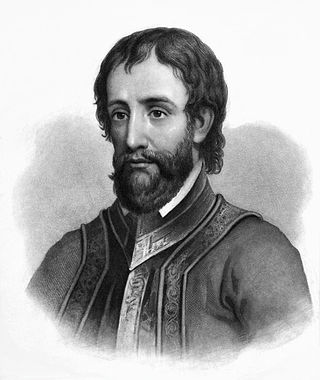
Hernando de Soto was a Spanish explorer and conquistador who was involved in expeditions in Nicaragua and the Yucatan Peninsula. He played an important role in Francisco Pizarro's conquest of the Inca Empire in Peru, but is best known for leading the first European expedition deep into the territory of the modern-day United States. He is the first European documented as having crossed the Mississippi River.

DeSoto County is a county located in the Florida Heartland region of the U.S. state of Florida. As of the 2020 census, the population was 33,976. Its county seat is Arcadia.

Juan Ponce de León was a Spanish explorer and conquistador known for leading the first official European expedition to Puerto Rico in 1508 and Florida in 1513. He was born in Santervás de Campos, Valladolid, Spain, in 1474. Though little is known about his family, he was of noble birth and served in the Spanish military from a young age. He first came to the Americas as a "gentleman volunteer" with Christopher Columbus's second expedition in 1493.

The Fountain of Youth is a mythical spring which allegedly restores the youth of anyone who drinks or bathes in its waters. Tales of such a fountain have been recounted around the world for thousands of years, appearing in the writings of Herodotus, in the Alexander romance, and in the stories of Prester John. Stories of similar waters also featured prominently among the people of the Caribbean during the Age of Exploration ; they spoke of the restorative powers of the water in the mythical land of Bimini. Based on these many legends, explorers and adventurers looked for the elusive Fountain of Youth or some other remedy to aging, generally associated with magic waters. These waters might have been a river, a spring or any other water-source said to reverse the aging process and to cure sickness when swallowed or bathed in.

The Freedom Tower is a building in Miami, Florida. It was designed by Schultze and Weaver and is currently used as a contemporary art museum and a central office to different disciplines in the arts associated with Miami Dade College. It is located at 600 Biscayne Boulevard on Miami Dade College's Wolfson Campus.

De Soto National Memorial is a national memorial located in Manatee County, approximately five miles west of Bradenton, Florida. The national memorial commemorates the 1539 landing of Hernando de Soto and the first extensive organized exploration by Europeans of what is now the southern United States. The memorial site comprises 26.84 acres (10.86 ha), where the Manatee River joins Tampa Bay. It has 3,000 feet (910 m) of coastline; eighty percent of the area is mangrove swamp.

Spanish Florida was the first major European land-claim and attempted settlement-area in northern America during the European Age of Discovery. La Florida formed part of the Captaincy General of Cuba, the Viceroyalty of New Spain, and the Spanish Empire during Spanish colonization of the Americas. While its boundaries were never clearly or formally defined, the territory was initially much larger than the present-day state of Florida, extending over much of what is now the southeastern United States, including all of present-day Florida plus portions of Georgia, South Carolina, North Carolina, Alabama, Mississippi, and the Florida Parishes of Louisiana. Spain based its claim to this vast area on several wide-ranging expeditions mounted during the 16th century. A number of missions, settlements, and small forts existed in the 16th and to a lesser extent in the 17th century; they were eventually abandoned due to pressure from the expanding English and French colonial settlements, the collapse of the native populations, and the general difficulty in becoming agriculturally or economically self-sufficient. By the 18th century, Spain's control over La Florida did not extend much beyond a handful of forts near St. Augustine, St. Marks, and Pensacola, all within the boundaries of present-day Florida.

Pascua Florida is a Spanish term that means "flowery festival" or "feast of flowers" and is an annual celebration of Juan Ponce de León's arrival in what is now the state of Florida. While the holiday is normally celebrated on April 2, it can fall on any date between the latter parts of March and the first week of April, depending on the day of the week April 2 falls on and/or the Governor's discretion. Pascua Florida Day is a state holiday.
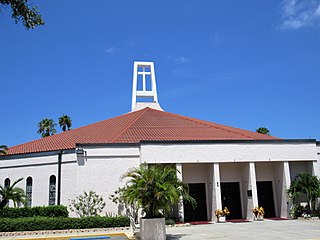
The Diocese of Venice in Florida is a Latin Church ecclesiastical territory–or diocese, of the Catholic Church in southwest Florida in the United States. It was founded on June 16, 1984.
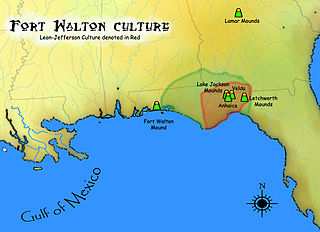
The Fort Walton culture is the term used by archaeologists for a late prehistoric Native American archaeological culture that flourished in southeastern North America from approximately 1200~1500 CE and is associated with the historic Apalachee people.
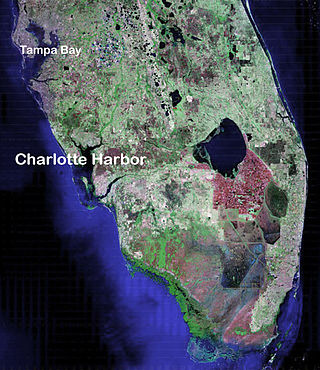
Charlotte Harbor Estuary, the second largest bay in Florida, is located on the Gulf of Mexico coast of west Florida with two thirds lying in Charlotte County, Florida and one in Lee County. The harbor's mouth is located behind Gasparilla Island, one of the many coastal barrier islands on the southwest coast of Florida, with access from the Gulf of Mexico through the Boca Grande Pass between Gasparilla Island on the north and Lacosta Island on the south. Charlotte Harbor covers about 270 sq mi (700 km2)

Isabel de Bobadilla, or Inés de Bobadilla was the first female governor of Cuba from 1539–1543.

Uzita (Uçita) was the name of a 16th-century native chiefdom, its chief town and its chiefs. Part of the Safety Harbor culture, it was located in present-day Florida on the south side of Tampa Bay.

The David W. Dyer Federal Building and U.S. Courthouse, formerly known simply as the U.S. Post Office and Courthouse, is an historic United States Post Office and federal courthouse of the United States District Court for the Southern District of Florida located at 300 Northeast 1st Avenue in Miami, Florida. Built in 1931 of limestone, it is the largest such structure in South Florida.

The Fountain of Youth Archaeological Park is a privately owned 15-acre (61,000 m2) park in St. Augustine, Florida, located along Hospital Creek, part of the Intracoastal Waterway. It has been touted as the likely 1513 Florida landing site of Spanish explorer Ponce de Leon, although no evidence has been found to substantiate this claim. Recent research by amateur historian Douglas Peck has placed another possible landing site in the vicinity of Melbourne Beach in Brevard County.

This is a timeline of the U.S. state of Florida.
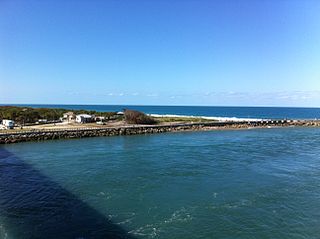
Ponce de León Island was a proposed name for the 45 miles (72 km) long, barrier island stretching from Cape Canaveral to Sebastian Inlet in Brevard County in central Florida, located on the Atlantic Ocean. The population was 67,933 at the 2010 United States Census. The barrier island is 21.4 square miles (55 km2). Another proposed name for this area was Ais Island after the native Ais people who originally inhabited the area. Currently, the island has not yet been designated any official name.
Urriparacoxi, or Paracoxi, was the chief of a Native American group in central Florida at the time of Hernando de Soto's expedition through what is now the southeastern United States. "Urriparacoxi" was a title, meaning "war leader". There is no known name for the people he led, or for their territory.

The Coral Gables Branch Library is one of 49 branches of the Miami-Dade Public Library System, located at 3443 Segovia Street in Coral Gables, Florida. It was established in 1927 by the Coral Gables Woman's Club.
Juan Ortiz was a Spanish sailor who was held captive and enslaved by Native Americans in Florida for eleven years, from 1528 until he was rescued by the Hernando de Soto expedition in 1539. Two accounts of Ortiz's eleven years as a captive, differing in details, offer a story of Ortiz being sentenced to death by a Native American chief two or three times, saved each time by the intervention of a daughter of the chief, and finally escaping to a neighboring chiefdom, whose chief sheltered him.























